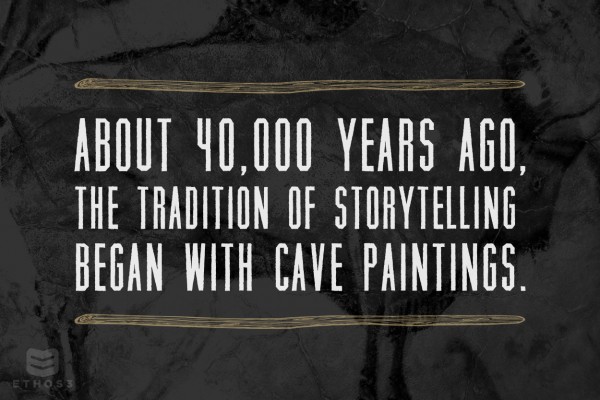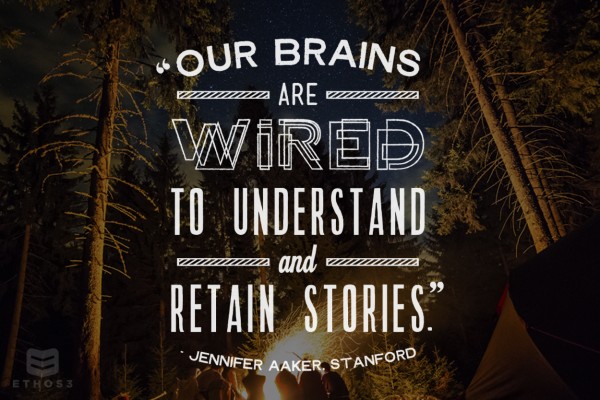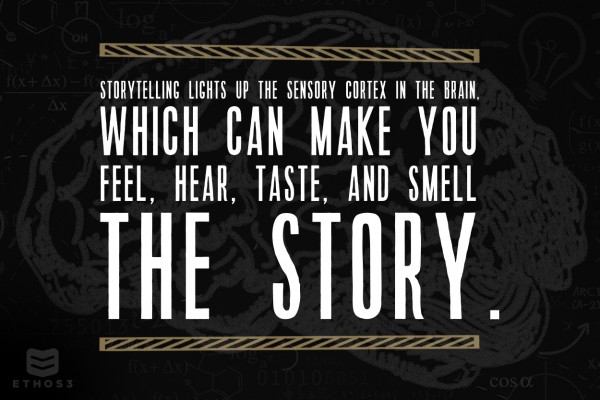We’ve often lauded the use of stories in your presentations; either to enhance the opening of your speech, or to build a framework for your overall approach. Understanding the draw of stories and using it to your advantage will not only make you a more memorable presenter, but a more compelling writer. In fact, we’ve built an entire business around it. Let’s explore the science of it.
The Neuroscience of Storytelling
When we say “storytelling,” we mean something more visceral than charts, graphs, and a three-part structure of a main idea. It’s the ancient concept of a tale told around a campfire: something that incites emotion and empathy. When you shift your perspective from “I need to tell something to my audience” to “I have something I want to share,” you begin to formulate a story, not merely a lecture. We’ve seen it work first hand.
The question remains: why do stories work so well? Why do they stick with us long after the speech is over, as with parables and jokes that we repeat again and again? What parts of our brains are specifically tuned to receive those signals?
The Science Behind It
We’ve been sharing stories with each other as a primary method of communication for over 40,000 years, or so the story goes. A story sticks in our memory and lasts much longer than say, a list of facts or information. In essence, this is due to how our brain processes information, and which areas of the brain “light up” when presented with differing information.
When we receive basic information, say a grocery list, we process the language within two areas of the brain (named after two neuroscientists of yore): “Broca’s area” and “Wernicke’s area.”
“It’s in fact quite simple. If we listen to a powerpoint presentation with boring bullet points, a certain part in the brain gets activated. Scientists call this Broca’s area and Wernicke’s area. Overall, it hits our language processing parts in the brain, where we decode words into meaning. And that’s it, nothing else happens.” Leo Widrich, Lifehacker
It’s straightforward stuff. Our brain is essentially tipping its hat at the new information to acknowledge that the data has been processed, but nothing “magical” occurs. When you add storytelling into the mix, the brain behaves completely differently.
Neuroscientists over the years have researched the different areas of the brain that respond to information by using an MRI to scan the brain’s response. For example, researchers at Emory University discovered that when their subjects read a descriptive metaphor rather than plain text, the sensory receptors in the cortex lit up. Our sensory cortex is responsible for transcribing actual things that happen to us, like the smell of hot chocolate or the way soft cotton sheets feel. According to the study: “Metaphors like “The singer had a velvet voice” and “He had leathery hands” roused the sensory cortex, while phrases matched for meaning, like “The singer had a pleasing voice” and “He had strong hands,” did not.”
Our brains, incredibly, are able to “light up” the same areas of actual, physical experience when we are exposed to storytelling and vivid language. Stories are the perfect vehicle for this miraculous, empathetic trip because they relate someone elses’ physical experience. For instance, Professor Keith Oatley of cognitive psychology at the University of Toronto has suggested that reading stories creates a simulation of reality which “runs on the minds of readers just as computer simulations run on computers.”
“Research shows our brains are not hard-wired to understand logic or retain facts for very long. Our brains are wired to understand and retain stories. A story is a journey that moves the listener, and when the listener goes on that journey they feel different and the result is persuasion and sometimes action.” Jennifer Aaker, marketing professor at Stanford’s Graduate School of Business
In short, storytelling illuminates parts of our brain that are only active when we actually experience something. We understand the rich detail and action of a story in a more complex way than if we were simply processing pieces of information. Think of data as seeing a sentence synopsis of a movie, and storytelling as going to see that movie in Imax 3D with the crazy moving seats.
How to Use It
How can you apply storytelling into a presentation that is composed of facts, graphs, and charts? If you want to engage your audience and acknowledge that a story would work, you can accomplish in two ways:
Verbal Only
Perhaps your presentation is primarily educational and needs some of those data points. Consider the “parable approach,” and sprinkle short, data-relevant stories throughout the text as you deliver your speech. Or simply engage your audience’s attention by starting or ending with a story as you begin and end the presentation.
Written + Verbal
Include a story that weaves in through the content and speech of your entire presentation. Not sure what that would look like? Here’s the storytelling presentation that put us on the map: Meet Henry.
If you can’t think of a story to tell that would be appropriate for your content, take a step back. There is definitely a story tucked in the recesses of facts and information: here are three ways you can find it:
1. Identify What Moves You
No great idea was born in dull darkness from nothingness. It took a muse, a kick in the pants, a difficult situation, a problem identified, or a task accomplished. What is the story behind your business, your passion, your year that brought you to this situation? Who or what inspires you? What is a mantra you repeat to yourself before you fall asleep? A story that incites empathy must be a real, vulnerable one that you have real, vulnerable feelings about.
2. Understand Your Audience
Something that always surprises us is when we are approached to make a corporate presentation in front of investors or other influential decision makers, and we are asked to keep the style as dry and lifeless as possible. The last we checked, people are people. Their sensory cortex still lights up when given a story to process: they aren’t hateful, unmovable sponges wearing ties. Tell the story that your audience wants to be apart of by first understanding their needs. No company does it better than Coca Cola:
“When it comes to marketing, a company like Coca-Cola gets this. They know that, deep down, they are much more a story factory than a beverage factory. No matter what they’d like us to believe, Coke’s success isn’t due to some magic in their fizzy syrup water (at least not since they took the actual cocaine out). Coke excels because they’ve been clobbering the opposition in the story wars for more than a century. People want to see themselves in the stories Coke tells. Coke understands that their customer is a member of the species Homo fictus, and that they will succeed or fail based largely on the power of their storytelling.” – “The Science of Storytelling” by Jonathan Gottschall
3. Consider a Structure
We’ve come up with an in-depth guide of a few storytelling structures that could work for your presentation. A shorter version is this: identify your protagonist, be clear about the challenge, and fill your story in with the details. You could also paint a picture of the future, relate a story to the past, or create a cliffhanger in the first portion of your presentation that is resolved later. The important thing is to understand that you aren’t stuck at sea with a pool noodle when it comes to creating a story: it’s totally acceptable to follow a structure.
How do we apply storytelling to the most corporate, data-driven decks that come through our door? When in doubt, create a fictional example story as we did with the “Meet Henry” presentation. How would an individual’s life become different if they used your product or service? What are some of their concerns, interests, and struggles? A fiction can be just as effective, and sometimes as fun, as relating your own personal narrative.
“Skillful storytellers can weave information about themselves they want the audience to know, without appearing to be pretentious. Past stories of struggles, failures and overcoming barriers the storyteller has experienced are excellent sources that help the teller connect with the audience as everyone has experienced these in life. This will compel the teller to appear more human, more like one of them.” Harvey Deutschendorf
Don’t let a conservative presentation worry you out of taking a storytelling approach: it’s one of the most effective ways to activate your audience’s sensory cortex, and in turn, their empathy and emotion for presentation.
Question: How can use utilize a story in your upcoming presentation?


